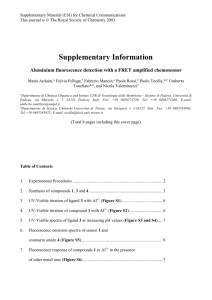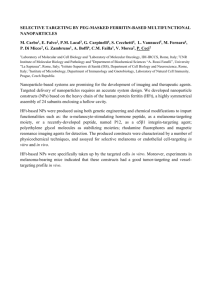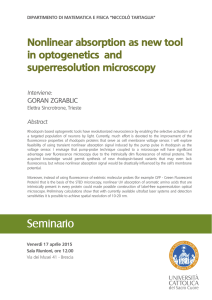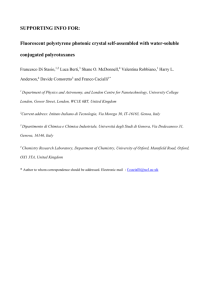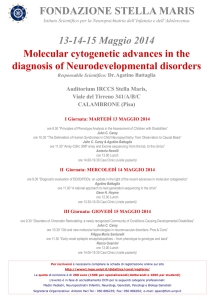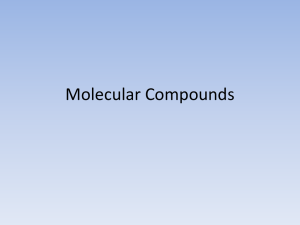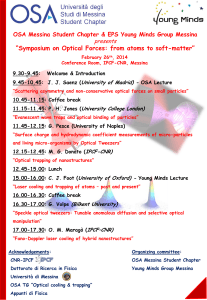Supporting information
advertisement
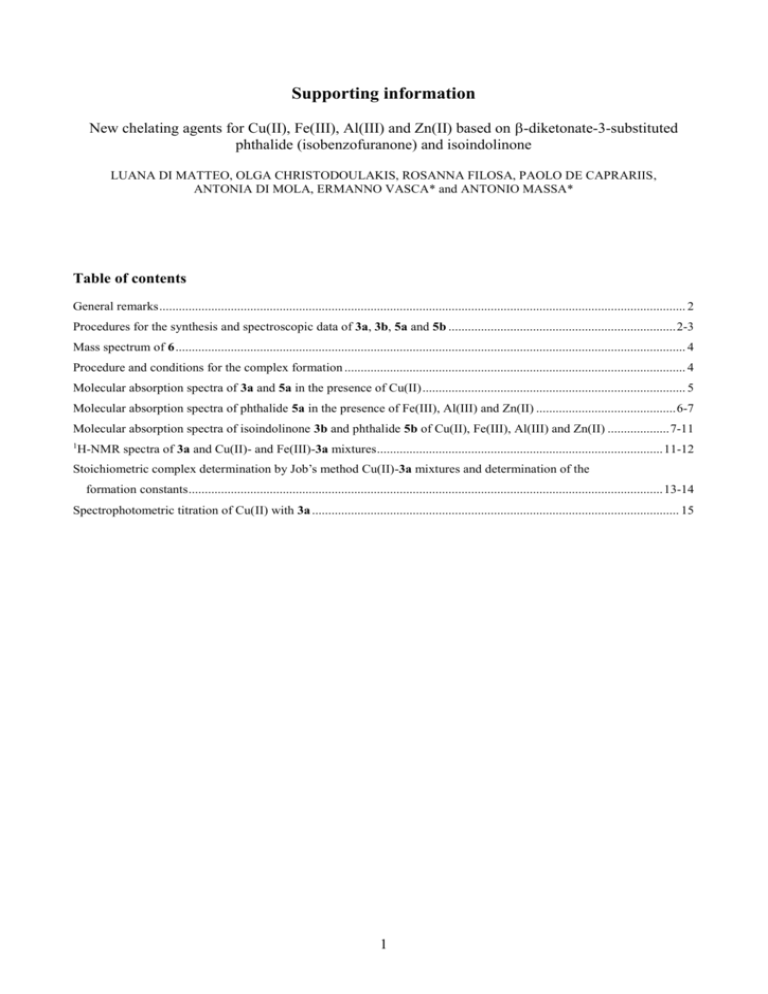
Supporting information New chelating agents for Cu(II), Fe(III), Al(III) and Zn(II) based on -diketonate-3-substituted phthalide (isobenzofuranone) and isoindolinone LUANA DI MATTEO, OLGA CHRISTODOULAKIS, ROSANNA FILOSA, PAOLO DE CAPRARIIS, ANTONIA DI MOLA, ERMANNO VASCA* and ANTONIO MASSA* Table of contents General remarks .................................................................................................................................................................. 2 Procedures for the synthesis and spectroscopic data of 3a, 3b, 5a and 5b ...................................................................... 2-3 Mass spectrum of 6 ............................................................................................................................................................. 4 Procedure and conditions for the complex formation ......................................................................................................... 4 Molecular absorption spectra of 3a and 5a in the presence of Cu(II) ................................................................................. 5 Molecular absorption spectra of phthalide 5a in the presence of Fe(III), Al(III) and Zn(II) ........................................... 6-7 Molecular absorption spectra of isoindolinone 3b and phthalide 5b of Cu(II), Fe(III), Al(III) and Zn(II) ................... 7-11 1 H-NMR spectra of 3a and Cu(II)- and Fe(III)-3a mixtures ........................................................................................ 11-12 Stoichiometric complex determination by Job’s method Cu(II)-3a mixtures and determination of the formation constants .................................................................................................................................................. 13-14 Spectrophotometric titration of Cu(II) with 3a ................................................................................................................. 15 1 General remarks Column chromatographic purification of products was carried out using silica gel 60 (70–230 mesh, Merck). The reagents (Aldrich and Across) were used without further purification. NMR spectra were in agreement with those reported in literature [1, 2]. Yields are given for isolated products showing one spot on a TLC plate and no impurities detectable in the NMR spectrum. Mass spectral analyses were carried out using an electrospray spectrometer, Waters 4 micro quadrupole. Elemental analyses were performed with FLASHEA 1112 series-Thermo Scientific for CHNS-O apparatus. UV-Vis analyses were performed on a double ray spectrophotometer Cary 1E Varian. 3-(3-oxo-2,3-dihydro-1H-isoindol-1-yl) pentane-2,4-dione 3a To a solution of acetylacetone (3.04 mmol) and Et3N (2.53 mmol) in CH2Cl2 (600 µL) at room temperature 2-cianobenzaldehyde (2.53 mmol) was added dropwise O O NH keeping to stir till solid formation (30 minutes). The solid was rinsed with a mixture of hexane/CH2Cl2 9/1, and dried under vacuum. Pale orange solid. Yield: 84% (491.8 mg, 2.13 mmol). 1H NMR and O 13 C NMR are in agreement with those reported in literature.1 MS (ESI): m/z = 254 (M + Na+). Anal. Calcd per C13H13NO3: C, 67.52; H, 5.67; N, 6.06. Found: C, 67.45; H, 5.36; N, 6.15. Dimethyl 2-(1-oxoisoindolin-3-yl) malonate 3b To a solution of dimethyl malonate (0.25 mmol) and K2CO3 (0.07 mmol) in CH3CN (0.9 mL) at room O temperature 2-cianobenzaldehyde (0.23 mmol) till O NH completion OCH3 O OCH3 monitored by TLC. Purification by flash chromatography (pentane/ethyl acetate 1/1) gave a white solid. Yield: 90% (54.5 mg, 0.207 mmol). 1H NMR and 2 13 C NMR are in agreement with those reported in literature [1]. MS (ESI): m/z = 286 (M + Na+). Anal. Calcd per C13H13NO5: C, 59.31; H, 4.98; N, 5.32. Found: C, 59.45; H, 5.04; N, 5.15. General procedure for the synthesis of 3-substituted phthalides 5 To a solution of 2-carbomethoxy benzaldehyde (0.31 mmol, 1 eq) and K2CO3 (0.093 mmol, 0.3 equiv.) active methylene compound (0.34 mmol, 1.1 equiv.) was added. The mixture was stirred at room temperature till starting material disappeared. Filtration on a short pad of silica gel gave the pure products. 3-(2,4-dioxopentan-3-yl)isobenzofuran-1(3H)-one 5a Filtration with hexane/ethyl acetate 7/3. Pale yellow oil. Yield: 99% O O (79 mg, 0.299 mmol). 1H NMR and O 13 C NMR are in agreement with those reported in literature.2 MS (ESI): m/z = 233(M + 1). Anal. Calcd per C13H12O6: C, 59.09; H, 4.58. Found: C, 59.24; H, 4.40. O Dimethyl 2-(1,3-dihydro-1-oxoisobenzofuranone-3-yl) malonate 5b Filtration with hexane/ethyl acetate 8/2. Yield: 99% (79 mg, 0.299 mmol). 1H NMR and 13C NMR are in agreement with those reported in literature.2 ESI-MS: m/z = O O 265 (M + 1). Anal. Calcd per C13H12O4: C,67.23; H, 5.21. Found: O OCH3 C, 67.12; H, 5.37. OCH3 O References [1] V. More, A. Di Mola, M. Perillo, P. De Caprariis, R. Filosa, A. Peduto, A. Massa. Synthesis, 3027 (2011). [2] A. Di Mola, G. Croce, V. More, P. De Caprariis, R. Filosa, A. Massa. Tetrahedron, 68, 6146 (2012). 3 Mass spectrum of 6 Procedure and conditions for the complex formation The complex of metal salts and isoindolinones 3a-b or phthalides 5a-b formed as reported in table 1. Try 3a + Cu(II) 3b + Cu(II) 5a + Cu(II) 5b + Cu(II) Mmol compd 0.0320 0.0320 0.0320 0.0320 Mmol (salt) 0.0160 0.0160 0.0160 0.0160 mL MeOH 6.000 6.000 6.000 6.000 3a + Fe(III) 3b + Fe(III) 5a + Fe(III) 5b + Fe(III) 0.0160 0.021 0.021 0.034 0.0160 0.021 0.021 0.034 6.000 10.000 10.000 6.000 3a + Zn(II) 3b + Zn(II) 5a + Zn(II) 5b + Zn(II) 0.0190 0.0190 0.0190 0.0190 0.0095 0.0095 0.0095 0.0095 6.000 6.000 6.000 6.000 3a + Al(III) 3b + Al(III) 5a + Al(III) 5b + Al(III) 0.0160 0.0160 0.0160 0.0160 0.0160 0.0160 0.0160 0.0160 6.000 6.000 6.000 6.000 0.0320 mmol of 3a-b or 5a-b were mixed in methanol (6.000 mL) with 0.0160 mmol of metals salts [Cu(II) or Zn(II)]. In the case of Fe (III) and Al(III) the ratio compound/metals was 1/1. 4 Molecular absorption spectra of 3a and 5a in the presence of Cu(II) Figure S1. Molecular absorption spectra recorded at 25 C in CH3OH. [Cu(II)] = 2.66 mM; Cu(II)/3a = 1:2. Optical path: 1 cm. Figure S2. Molecular absorption spectra recorded at 25 C in CH3OH. [Cu(II)] = 2.66 mM; Cu(II)/5a = 1:2. Optical path: 1 cm. 5 Molecular absorption spectra of phthalide 5a in the presence of Fe(III), Al(III) and Zn(II) Figure S3. Molecular absorption spectra recorded at 25 C in CH3OH. [FeCl3] = 0.35 mM, Fe(III)/5a = 1:1. Optical path: 1 cm. Figure S4. Molecular absorption spectra recorded at 25 C in CH3OH. [Al(III)] = 0.44 mM; Al(III)/5a = 1:1. Optical path: 1 cm. 6 Figure S5. Molecular absorption spectra recorded at 25 C in CH3OH. [Zn(II)]= 0.16 mM; Zn(II)/5a = 1:2. Optical path: 1 cm. Molecular absorption spectra of isoindolinone 3b and phthalide 5b in the presence of Cu(II), Fe(III), Al(III) and Zn(II) Figure S6. Molecular absorption spectra recorded at 25 °C in CH3OH. [Cu(II)] = 2.66 mM; Cu(II)/3b = 1:2. Optical path: 1 cm. 7 Figure S7. Molecular absorption spectra recorded at 25 °C in CH3OH. [Fe(III] = 0.35 mM, Fe(III)/3b = 1/2. Optical path: 1 cm. Figure S8. Molecular absorption spectra recorded at 25 °C in CH3OH. [Zn(II)] = 0.16 mM, Zn(II)/3b = 1/2. Optical path: 1 cm. 8 Figure S9. Molecular absorption spectra recorded at 25 °C in CH3OH. [Al(III)] = 0.44 mM, Al(III)/3b = 1/1. Optical path: 1 cm. Figure S10. Molecular absorption spectra recorded at 25 °C in CH3OH. [CuSO4] = 2.66 mM, Cu(II)/5b = 1:2. Optical path: 1 cm. 9 Figure S11. Molecular absorption spectra recorded at 25 °C in CH3OH. [Fe(III] = 5.7 mM, Fe(III)/5b = 1/1. Optical path: 1 cm. Figure S12. Molecular absorption spectra recorded at 25 °C in CH3OH. [Al(III)] = 0.44 mM, Al(III)/5b = 1/1. Optical path: 1 cm. 10 Figure S13. Molecular absorption spectra recorded at 25 °C in CH3OH. [Zn(II)] = 0.16 mM, Zn(II)/5b = 1/2. Optical path: 1 cm. 1 H-NMR spectrum of 3a 11 1 H-NMR spectrum of Cu(II)-3a 12 Stoichiometric complex determination by Job’s method and determination of the formation constants Table S1. Mixtures concentration of isoindolinone, metal and L/Cu ratio for Job's method. Solution CL, mM CCu(II), mM CL / CCu Cu(II) 0 30.07 0 1 2.73 27.34 0.1 2 6.01 24.06 0.25 3 10.02 20.05 0.50 4 12.88 17.19 0.75 5 14.24 15.83 0.90 6 15.035 15.035 1.00 7 15.75 14.32 1.10 8 16.70 13.37 1.25 9 18.04 12.03 1.50 10 19.13 10.94 1.75 11 19.70 10.37 1.90 12 20.05 10.02 2.00 L 30.07 0 0 13 0,35 Abs 0,30 Cu(II) 1) L/Cu=0.10 2) L/Cu=0.25 3) L/Cu=0.50 4) L/Cu=0.75 5) L/Cu=0.90 6) L/Cu=1.00 7) L/Cu=1.10 8) L/Cu=1.25 9) L/Cu=1.50 10) L/Cu=1.75 11) L/Cu=1.90 12) L/Cu=2.00 Isoindolinone (16) 0,25 0,20 0,15 0,10 0,05 Wavelength, nm 0,00 400 500 600 700 800 900 Figure S17. UV Spectrophotometric titration of 30.07 mM CuSO4 with 30.07 mM 3a in CH3OH. Temperature: 25 °C; optical path: 1 cm. 0,040 A (=500 nm) x=0,62 0,035 0,030 0,025 y = 0,053 - 0,026 x 0,020 0,015 0,010 y = 0,005 + 0,052 x 0,005 0,000 0,0 CL / (CL + CCu) 0,2 0,4 0,6 0,8 Job's plot of Cu(II)-3a complex 14 1,0 Spectrophotometric titration of Cu(II) with 3a Two different solutions in CH3OH were prepared: isoindolinone 3a (0.120 M) and CuSO4 (20.08 mM). Starting from 2.000 mL of the Cu(II) solution, 50 µL additions of isoindolinone solution were done, till reaching 1.000 mL of titrant volume. After each addition, the UV-Vis spectrum of the solution was recorded, in the visible wavelength interval. 15
